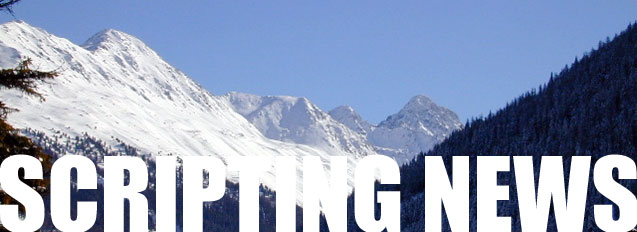
 What is a blorkmark?
What is a blorkmark? I'm working on the top-level user interface for the worldoutline software, and have decided, for now at least, that blorkmarks will be a top level feature. I could leave them out in the first version, and introduce the concept as an upgrade a few months after the initial release. I might still do that. But I wanted to see if I could explain what they are to the relatively technical people who read this blog.
The core idea in the worldoutline is that you can put a marker on a headline that says this place begins a new space. Which allows you to use the outliner to organize all your spaces.
This way of organizing has lots of advantages. It lets you view a blog as a structure of documents you can edit. And it can allow you to fork off a new blog without increasing the complexity of the world you manage. This is something you're constantly fighting. A lot of spaces shouldn't overly complicate your life.
So how does a seam get expressed? How are these markers implemented? You could either come up with a web service that takes a name and tells you how to find your way to that place, or you could use a system that already does most of the job, DNS. This is one of my basic design principles. When possible use already-deployed and widely-supported protocols instead of inventing new ones. Lots of good reasons for this. That's why I used DNS. It scales, it's widely deployed, and I've always felt it was under-utilized, that there was a lot of power there lying dormant.
So here's how it works from a user standpoint. I put the cursor on a headline, and choose the Add Blorkmark command. It suggests a name, which I can override. Then it makes a call to a server which in turn calls Amazon's Route53, to register a cname, and associate it with the node you're pointing to. It takes 20 to 40 seconds for Amazon to do its work. And after that you have a way to get to this place. To the reader it looks as if it's a world unto itself, but in your view of the world, it's just a corner inside a bigger outline. A possibly much bigger outline, containing many such spaces.
The path to the node is stored locally on your machine and on your worldoutline server. If you move it, no problem, the marker moves with it. So that's what a blorkmark is. It's something like a bookmark, but it points into content both in the place you edit it and in the place people read it.
 Riding round the Meer
Riding round the Meer Today's milestone ride -- all the way round the park -- with confidence.
I had been taking a shortcut, eliminating the steepest part of the ride in Central Park, around the top of the park. I had ridden it before and always had found the hill a bit too much for my legs and my lungs.
This morning the conditions were ideal, I was feeling good, it was a very comfortable 60 degrees, no cars, not too much bike traffic and no pedestrians, so I went for it. Yes! It was very doable. I'm in good shape for this hill. Knock wood, IANAL, MMLM and all the usual disclaimers.
Also, no matter how early you get out on a spring morning there's always something big going on in the park. Today it's the AIDS Walk. Hasn't started yet, but you can tell there will be a hundred thousand people walking where I was riding today. Things in NY scale like that. And Central Park is probably nothing like Olmstead imagined it, as a place for contemplation. It is, however, a place where the people of the city mingle. All classes, it seems. And people from all over the world.
And since this may be the only blog post today, I'd like to add that Nic Cubrilovic probably summed up Zuck's fabulous weekend best, from a male point of view. "How can you beat IPO and married in the same weekend?" he said "Err, IPO and not married." My guess is that Zuck liked things pretty much as they were. But of course I'm projecting! ![]()
Today's map: 47 minutes, 8.30 miles, average 10.58 mph.